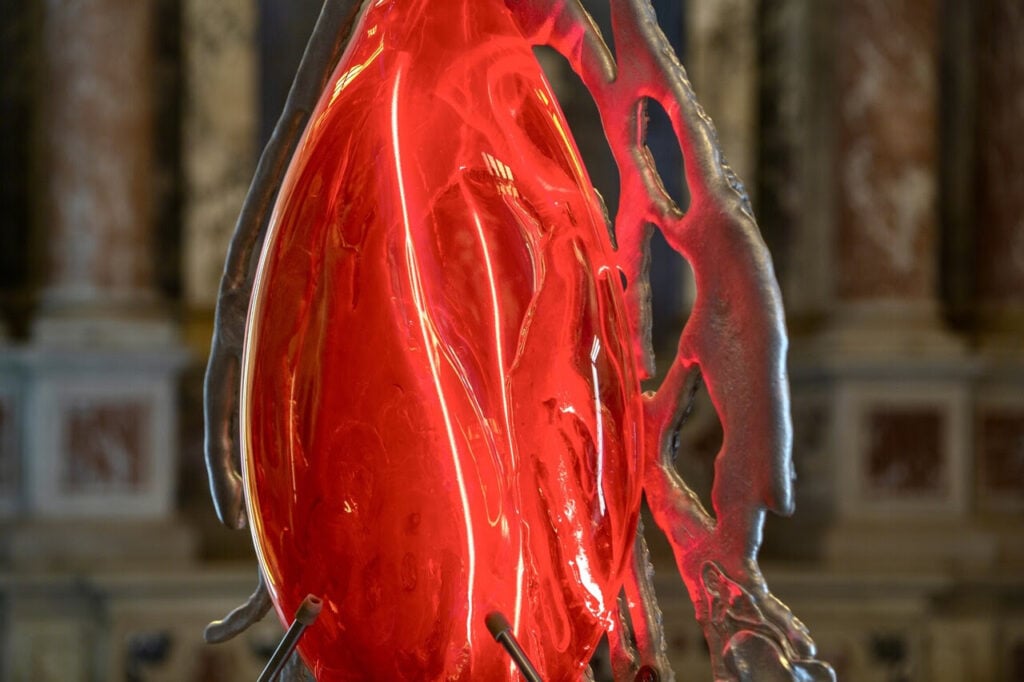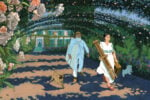60. Biennale – Padiglione Lituania

Pakui Hardware and Marija Teresė Rožanskaitė rappresentano la Lituania alla Biennale di Venezia.
Comunicato stampa
| Pakui Hardware and Marija Teresė Rožanskaitė Inflammation April 20–October 31, 2024 |
| Opening: April 19, 6–7pm |
| |
| Book presentation: April 20, 2–3pm, Marija Teresė Rožanskaitė: X-Rays of Art and Life |
| |
| Lithuanian Pavilion at the Venice Biennale Salizada S. Antonin, 3477 Chiesa di Sant'Antonin 30122 Venice Italy Hours: Tuesday–Sunday 11am–7pm |
| |
| www.lndm.lt Facebook / Instagram |
| The Pavilion of Lithuania at the 60th Venice Biennale presents Inflammation, an installation by artist duo Pakui Hardware (Neringa Černiauskaitė and Ugnius Gelguda) that features paintings by Marija Teresė Rožanskaitė (1933–2007), curated by Valentinas Klimašauskas and João Laia. The installation features landscape and architecture of the environment by Petras Išora and Ona Lozuraitytė and is staged in the Chiesa di Sant’Antonin.
The Pavilion opens to the public on April 19 at 6pm. It will be open to the press during the preview days, April 17–19, from 11am until 7pm and on April 16 by appointment only. Inflammation brings together two artistic practices belonging to different generations and explores the inflammation of (post)human bodies under today’s economic and social conditions. Marija Teresė Rožanskaitė’s paintings and a sculptural installation by Pakui Hardware (in collaboration with Išora x Lozuraitytė Studio) connect via their exploration of questions related to medicine and health, as well as natural, cosmic, and industrial landscapes. The combined presentation conveys the interconnectedness of bodies and environments in crisis while offering a metabolic balance, helping to cool the burning human and planetary bodies. The fused aluminum and glass sculptures by Pakui Hardware resemble enlarged nervous systems with pulsating hot spots of inflammation. Like bodies, they come to life when touched by a burning beam that resembles spatial or organ scanning. The prosthetic motif—using silicone membranes and medical or laboratory materials—is further expanded by the way the distinct elements merge into a larger unified installation, a techno-organism. In Rožanskaitė’s paintings, unnamed diseases, sterile operating theaters and medical consultation rooms, visceral-themed assemblages, and machine-like objects radiate chronic inflammations of the cosmic flesh. The project draws direct inspiration from Marya Rupa and Raj Patel’s 2021 book Inflamed: Deep Medicine and the Anatomy of Injustice, which employs inflammation as a metaphor for the systemic harm inflicted on humanity and the planet. Inflammation, according to the authors, is the body’s normal response to toxic conditions, and rather than targeting individual unhealthy organs, treatment should begin by addressing the very systems—economic and social—that cause chronic ailments to be passed from one generation to the next. The book and the exhibition connect the human and the planetary scales. Not only are our bodies aflame, but so is the Earth. Another critical thread, which has also been evolving in the artists’ work, is the questioning of Western cosmology, characterized by constant divides and separations, between mind and body and between human and nature, of what is considered our own and what belongs to the realm of the other. In this delirious post-landscape, it is difficult to distinguish between what might be attributed to nature and what could be a human creation. Objects referring to human bodily systems in a state of inflammation are set in an architectural post-natural landscape of hybrid soil, light, and technology, all merging into a unified hybrid techno-organism. For this year’s edition, the commissioner and the curators chose the iconic Chiesa di Sant’Antonin, a church that has never hosted a national pavilion before. The church, traditionally a site of faith, community, and transcendence, is transformed into a liminal space. Pakui Hardware’s contemporary installation and the modern figurative paintings by Rožanskaitė meet in the historic hall to create an immersive landscape, gesturing towards a future of potential healing. A catalogue accompanying the exhibition is published by Mousse Publishing and the Lithuanian National Museum of Art with texts by Arūnas Gelūnas, Estelle Hoy, Petras Išora and Ona Lozuraitytė, Valentinas Klimašauskas, Inga Lāce, and João Laia. Producer: Lithuanian National Museum of Art |



